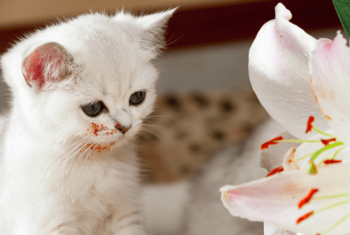Researchers find “forever chemicals” in pet cats and dogs.
From nonstick cookware to clothing and cosmetics, industrial chemicals can be found in many of the items we use every day. One specific class of chemicals, per- and polyfluoroalkyl substances (PFAS), has recently been the topic of increased scrutiny as they are used in more and more places, including some food packaging, clothing, cleaning products, and water supplies.
Researchers are starting to understand more about how these PFAs interact with the environment and in the body. Now, scientists have also found these chemicals in household pets (yes, our beloved cats and dogs).
What They Found
New York State Department of Health researchers tested the feces of cats and dogs for 15 different types of PFAS and found 13 “forever chemicals.” The findings further showed that the pets had been exposed to some PFAS at levels above the accepted minima for humans. Although this study confirmed that pets are being exposed, researchers did not study blood or tissue levels of PFAs, so long-term accumulation rates are not known.
Since 2002, the use of PFAS has declined. However, some PFAS studies suggest that at high concentrations, they may increase the risk of cancer, disrupt hormones including thyroid function, and harm the immune system. While PFAS research is still in its infancy, PFAS exposure may also be harmful for pets. In the study, authors cited research that showed that PFAS had toxic effects on animals’ genes, livers, and brains.
What This Means for Pet Owners
So, what can pet owners do to avoid PFAS? While further investigation into the transmission and effects of PFAS is needed and PFAS are difficult to entirely avoid, there are still ways owners can screen potentially harmful common household items, such as food, polishes, waxes, paints, varnishes, and cleaning products.
Jessica Romine, DVM, DACVIM, Board Certified in Veterinary Internal Medicine, BluePearl Specialty and Emergency Pet Hospital in Southfield, Mich., is offering pet owners a few precautionary tips.
Think of pets like toddlers: they play on the floor and will eagerly put their paws and all sorts of different household items in their mouths. So, their exposures to the chemicals found in waxes and polishes, cleaning products, dust, and so forth, are potentially greater,” explained Dr. Romine. “Although the effects of ‘forever chemicals’ are not yet fully understood, there are some preventative measures owners can take to lessen the risk of exposure, such as avoidance of stain- and/or water-resistant furniture and clothing and opting for natural cleaning products.”
Follow These Expert Tips
- Avoid stain- and water-resistant furniture, carpets/rugs, and clothing. When possible, choose alternatives to clothing (particularly, rainwear), furniture, and carpets/rugs that have been treated for water or stain resistance. Consider limiting application of water- or stain-proof treatments to these or other items, including dog/cat beds, shoes, luggage, and outdoor or sports gear.
- Watch your food wrappers. Food packaging, such as popcorn bags, pizza boxes, and fast food wrappers, often contain grease-repellent coatings. This, along with the risk of intestinal blockage from consumption of wrappers, makes these items extremely dangerous for pets. If microwaveable popcorn, pizza, and/or fast food is a quintessential diet item, be sure to properly dispose of packaging when finished.
- Screen personal and pet care products. Scan personal or pet care product ingredient lists for the words “perfluoro” or “fluoro.” This class of potentially harmful chemicals, called PFCs, can be found in various personal care (shampoo, dental floss) and cosmetic products (nail polish, eye makeup). If you choose to keep these items around, keep them out of pets’ reach, such as in cabinets and drawers.
- Consider changing your cookware and dishes. Many plastic bowls/plates and non-stick cookware and products (e.g., Teflon) contain hormone and immune disrupting chemicals. If you cook food for yourself and/or your pet on a non-stick pan, be careful not to let the pan heat to above 450ºF and immediately dispose of cookware if it begins to show signs of deterioration. Opt for cast-iron, stainless steel, ceramic (stoneware) cookware and bowls (when possible).
- Use natural cleaning products. Some household and office cleaning products contain PFAs, which can lead to direct exposure from product use. This aside, several common chemical-cleaning agents are toxic to dogs and cats. If you are removing pet odors and stains in an enclosed space, opt for non-toxic, pet-safe, and/or green cleaning products, and be sure to keep the room(s) well ventilated. Cats are particularly sensitive to lots of these compounds in the air, including essential oils so they always need an opportunity to exit rooms where these are being used. Avoid cleansers containing bleach, isopropyl alcohol, formaldehyde, and phenols, as these ingredients are particularly dangerous if consumed by pets.
Pets are continuously subjected to chemical exposures in homes, parks, yards, and gardens. While an owner may feel it their obligation to protect their dog or cat, they cannot always prevent exposure to these chemicals and eliminating all contaminants is close to impossible,” explained Dr. Romine. “It’s important to keep in mind that pets use their mouths to clean themselves. Any chemical residue left over from cleaning or personal care products may attach to their coats or paws and be licked off and ingested. Best practice is to refrain from introducing toxic chemicals in your home altogether.”
The Takeaway
Our pets breathe and ingest the same industrial chemicals that we breathe and ingest, so it is important we take appropriate steps to keep our furry loved ones and ourselves safe. While many people will feel most comfortable trying to avoid PFAs and similar compounds altogether, it is nearly impossible to completely eliminate them, particularly through water and soil routes. Make sure to thoroughly read the label and educate yourself on the dangers associated with each chemical before use around people and pets.
If you think your pet has ingested a harmful substance and is showing signs of distress, immediately contact your veterinarian and/or the Pet Poison Helpline (855) 764-7661 (incident fee applies).


